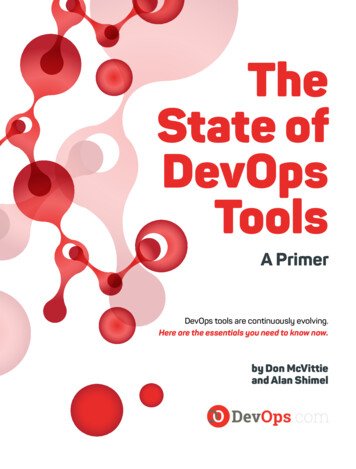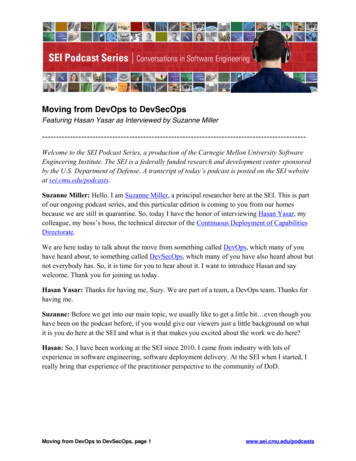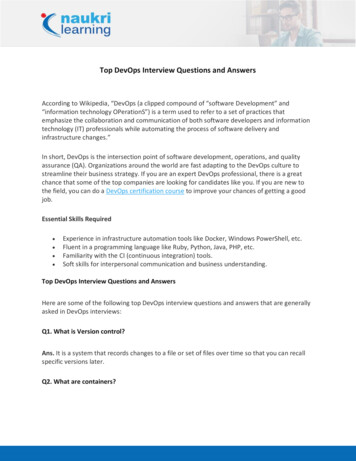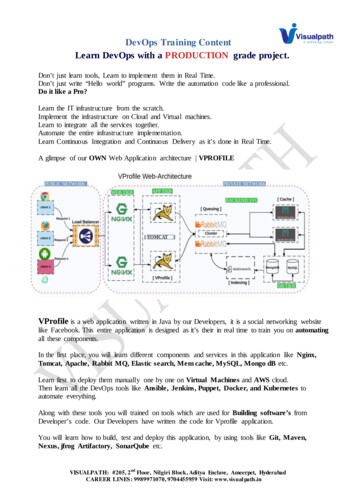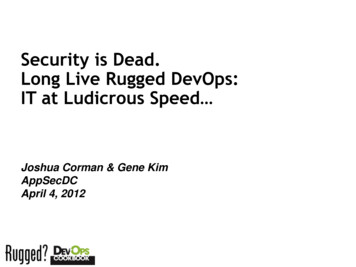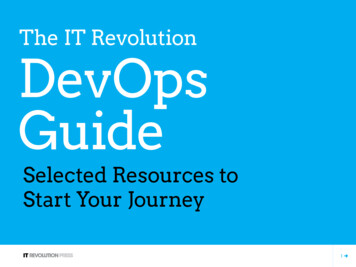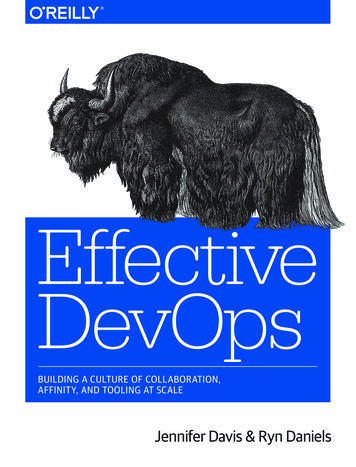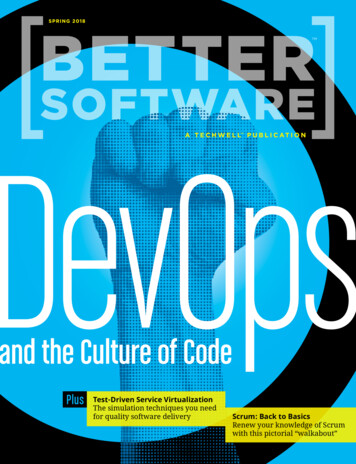
Transcription
DevOpsand the Culture of CodePlusTest-Driven Service VirtualizationThe simulation techniques you needfor quality software deliveryScrum: Back to BasicsRenew your knowledge of Scrumwith this pictorial “walkabout”
What Are Past Attendees Saying?about the TOPICSabout the KEYNOTES“I very much enjoyed beingable to cross-attend thevarying topics to gain alarge content of ideas.”Tim Robert, Systems Analyst,State Farm“The keynotes were inspiring! Therewere several practical talks. Gave metime to think and network to developactionable takeaways.”Pete Lichtenwalner, Sr. Engineer Manager, Verintabout the TUTORIALSabout the SPEAKERS“Great speakers that show they arepassionate about what they do. Plus theyare open to share ideas and experiences.”Verita Sorsby, QA Manager, Tio Networks“Excellent conference. Thetutorials were invaluable tome and my group.”Jennifer Winkelmann, BusinessAnalyst, TD AmeritradeAgile Dev topic areas:Better Software topic areas:DevOps topic areas: Scaled Agile Development Agile Testing Agile Implementation Career & Personal Development Agile Teams & Leadership And More Digital Transformation Process & Metrics Software Quality & Testing Requirements & User Stories Project Management And More Architecture & Design Configuration Management DevOps and Test/QA Continuous Delivery Continuous Integration And MoreJUNE 3–8, 2018LAS VEGAS, NVCAESARS PALACERegister byMay 4, 2018,with code CWBSMto save up to 600 off yourconference*TO R EG I ST E R , C A L L 8 8 8 . 26 8 . 87 70 B SC W E ST.T EC H W E L L .CO M*Discount valid on packages over 400
SAVE THE DATE FOR THE INAUGURAL EVENT!ATD U S AJUNE 25–29, 2018BOSTON, MAEurope’s fun and widely popular agiletesting festival is coming to NorthAmerica as Agile Testing Days USA. Thisevent will feature over 50 of the top agiletesting enthusiasts speaking in Boston.https://agiletestingdays.usSUPER EARLYLOBSTERSAVINGSWHEN YOUREGISTER BYAPRIL 27, 2018
DevOpsIN SID EVolume 20, Issue 2and the Culture of CodeSPRING 2018DevOps and the Cultureof CodeMigrating an organization tocontinuous integration requiresadoption new processes, tools,and automation. DevOps relieson dramatic culture change toencourage total transparencyand collaboration among allproject stakeholders.14FeaturesOn the Coverby Patrick TurnerBETTER SOFTWARE14TechWell.com1926Test-Driven Service VirtualizationScrum: Back to BasicsBecause enterprise applications are highly interconnected,development in stages puts a strain on the implementationand execution of automated testing. Service virtualization canbe introduced to validate work in progress while reducing thedependencies on components and third-party technologiesstill under development. by Alexander MohrSo you think you know Scrum? Using the whimsical notionof farm animals and light-hearted visuals, take a refreshingreview of the entire Scrum lifecycle as an intuitive set of roles,responsibilities, and handoffs. Particular attention is placed onwhat the ScrumMaster and product owner are expected to doat each handoff. by Brian RabonColumns09DepartmentsTECHNICALLY SPEAKINGBuilding a Test AutomationStrategyQA departments always feel thepressure to start testing quickly, even ifthe ever-changing software being testedisn’t ready. A bought-in test automationstrategy can keep a project on track.by Justin Rohrman34THE LAST WORDThe Unspoken Truth about IoTTest AutomationThe internet of things (IoT) continues toproliferate as connected smart devicesbecome critical for individuals andbusinesses. Even with test automation,performing comprehensive testing canbe quite a challenge. by Rama R. Anem060708123235Mark Your CalendarEditor's NoteContributorsInterview with an ExpertTechWell InsightsAd IndexBetter Software magazine brings you the hands-on, knowledge-building information you need to run smarter projects and deliver betterproducts that win in the marketplace and positively affect the bottom line. Subscribe today at BetterSoftware.com or call 904.278.0524.BETTER SOFTWARETechWell.com5
M A R K YO U R C A L E N DA RSQE TRAININGAT E C H W E L LHelping organizations worldwide improve their skills, practices,and knowledge in software development and testing.C O M P A N YSoftware Tester Certification—Foundation Levelhttp://www.sqetraining.com/certificationApril 9–13, 2018May 1–3, 2018May 15–17, 2018June 5–7, 2018April 29–May 1, 2018May 15–17, 2018June 5–7, 2018June 19–21, 2018Virtual classroomPhiladelphia, PAOrlando, FLDenver, COSan Diego, CANashville, TNJersey City, NJAustin, TXDevOps WeekLean Kanban WeekApril 16–20, 2018May 7–11, vops-weekWashington, -kanban-weekSeattle, WAConferenceseventsApr. 29–May 4, 2018Orlando, FLLEARN MORECutting-edge concepts, practical solutions, and today’s most relevant topics.TechWell brings you face to face with the best speakers, networking, and ideas.June 3–8, 2018Las Vegas, NVJune 25–29, 2018Boston, MALEARN MORELEARN MORESep. 30–Oct. 5, 2018Oct. 14–19, 2018LEARN MORELEARN MOREAnaheim, CAToronto, ONNov. 4–9, 2018Orlando, FLLEARN MOREBETTER SOFTWARETechWell.com6
EDITOR’S NOTECoworking Communities Are Changing How SoftwareIs DevelopedThe traditional office workspace is a dinosaur. Software professionals want a different work-life balance. They want the freedom to work from home but still have the experience of working in a teamsetting. Small-town tech hubs and coworking are the future. Steve Case, cofounder of the Washington,DC-based venture capital firm Revolution LLC, started a crusade with Rise of the Rest , a nationwidetraveling initiative to support and promote entrepreneurs in emerging startup ecosystems.As Josh Dorfman, the director of entrepreneurship at Venture Asheville and managing director atAsheville Angels, told me “One of the greatest values of coworking is serendipity. It is very likely thatKen Whitakeryou will be sitting down next to others who can benefit your business. I see it all of the time.” J.D.kwhitaker@techwell.comClaridge, the CEO of software-powered drone maker xCraft, embraces coworking at the InnovationTwitter: @Software ManiacCollective located in Coeur d’Alene, Idaho. It isn’t just because of the amazing espresso bar and thecentral presentation conference center. “The coworking office environment gives us flexibility,”Claridge said. “We use it as a hub to manage a diverse team throughout the US and with contractorsin other parts of the world.” Living and working where we want to be is a dream come true.Now, I’d like to switch gears and present the content of the Spring 2018 issue of Better Software. Ourfeatured cover article is Patrick Turner’s “DevOps and the Culture of Code,” which emphasizes theimportance of organizational culture required to embrace continuous DevOps operations.Service virtualization is taking off, and testing requires special considerations. Alexander Mohr walksyou through the entire testing lifecycle in “Test-Driven Service Virtualization.” After years leading agile teams, I thought I knew Scrum—until I read Brian Rabon’s “Scrum: Back to Basics.” And if you’reFOLLOW USinterested in test automation, Justin Rohrman gives great advice in “Building a Test AutomationStrategy” and Rama Anem shows how intelligent devices need to be tested in “The Unspoken Truthabout IoT Test Automation.”We truly value your feedback. Let us and our authors know what you think of the articles by leavingyour comments. I sincerely hope you enjoy reading this issue as much as we enjoy working withthese wonderful authors. Don’t forget to spread the word and let people know about TechWell andBetter Software magazine.PUBLISHERTechWell CorporationPRESIDENT/CEOAlison WadeDIRECTOR OF PUBLISHINGHeather ER SOFTWARE EDITORCREATIVE DIRECTORSALES CONSULTANTSMARKETING MANAGERSKen WhitakerONLINE EDITORSJamie Bordersjborders.comJosiah RenaudinBeth RomanikDaryll PaivaKim TrottPRODUCTION COORDINATORAlex DinneyCristy BirdMARKETING ASSISTANTAllison ScholzPRODUCTION COORDINATORDonna HandforthCONTACT USEDITORS:editors@bettersoftware.comSUBSCRIBER SERVICES:info@bettersoftware.comPhone: 904.278.0524,888.268.8770Fax: 904.278.4380BETTER SOFTWARETechWell.comADDRESS:Better Software magazineTechWell Corporation350 Corporate Way, Ste. 400Orange Park, FL 320737
CONTRIBUTORSRama R. Anem has more than thirteen years of testing experience and is a test architect at Sunpower Corporation. At AMD, she managed the enterprise-wide data platform quality practice and was responsible for building its first center of excellence. At IBM, Rama lead multiple teams and served as one of the brand ambassadors for DB2. In addition to writing articles in a variety of technical journals, she also presents advanced topicsat international software conferences and workshops. Rama can be reached at rama.anem@gmail.com.Starting as a developer, Alexander Mohr has been working in software development since 2000 in a varietyof roles. Since then he has worked as a product owner, business analyst, test manager, architect, and projectmanager. Recently, Alexander introduced test-driven service virtualization for a large Austrian telecommunication provider as a groundbreaker for “shift left.” Now, he works for Tricentis as an evangelist for servicevirtualization and agile transformation. Alexander can be contacted at a.mohr@tricentis.com.Brian Rabon is the president of The Braintrust Consulting Group, a worldwide leader in agile transformations. Throughout his seventeen years of IT industry experience, Brian has applied agile methods in order tosuccessfully deliver working products to his customers. When not in the classroom, Brian can be found aroundthe globe evangelizing the benefits of agility. Brian is the author of Scrum for the Rest Of Us and an avid blogger. To contact Brian, please email him at brian.rabon@braintrustgroup.com or join him on LinkedIn.A longtime freelancer in the tech industry, Josiah Renaudin is now a web-content producer and writer forTechWell Insights, StickyMinds.com, and Better Software magazine. He wrote for popular video game journalism websites like GameSpot, IGN, and Paste Magazine and now acts as an editor for an indie project publishedby Sony Santa Monica. Josiah has been immersed in games since he was young, but more than anything, heenjoys covering the tech industry at large. Contact Josiah at jrenaudin@techwell.com.Justin Rohrman has been a professional software tester since 2005. In addition to being technical editor ofStickyMinds.com, Justin is a consulting software tester and writer working with Excelon Development. He alsoserves on the Association for Software Testing board of directors. As president, Justin helps facilitate and develop programs like BBST, WHOSE, and the CAST conference. Contact Justin at rohrmanj@gmail.com.Patrick Turner discovered a passion for computers at the age of ten on a trip to a local Radio Shack with hisbrother. He has more than twenty years of experience producing software solutions for a broad range ofbusiness needs. In addition to being an accomplished public speaker, Patrick is the CTO of Small Footprint andoversees a unique model of blending experienced American software development professionals with talentedRomanian software engineers. Patrick can be reached at pturner@smallfootprint.com.BETTER SOFTWARETechWell.com8
TECHNICALLY S PEAKIN GBuilding a TestAutomation StrategyTEST AUTOMATION IS OFTEN VIEWED AS THE PANACEA THAT SOLVES ALL QUALITYISSUES. BUT LIKE OTHER TESTING, TEST AUTOMATION REQUIRES A STRATEGIC PLAN.by Justin Rohrman rohrmanj@gmail.comIt is the end of a sprint and we still don’t know much aboutnew to go wrong in surprising parts of the product. Developersthe overall quality of the product. For the past decade, the popu-want quick feedback to know if their code is doing what they ex-lar approach to this problem has been to batch up the test ideaspect and to know if they broke anything that was already working.we created in this sprint, add some from the last few releases,Some developers will create small tests that run a bit of code toand perform them all. Ideally, we findsimply check a value. In an ideal world,a bunch of surprising problems thata developer makes a change and thenwere introduced over the course ofruns a test. This results in receivingthe past sprint. This process, knownas regression testing, usually takes afew days to perform. From a manager’s perspective, the only good thing todo with regression testing is to make ittake less time.I have been employed at more thanone company where this scenario leadsto a group of testers—usually with little to no programming experience—attempting to build a UI automationsolution. After a year of development,they have a build that took three hoursto complete and tests that passed orFor mostprojects, testingwith code isbetter done bythe people whoare writing theproduction code.failed unpredictably. Understandably,management is shocked and disappointed when the automationproject ends up as a mess.feedback from that test within seconds.If the test fails, they check their code.If the test passes, they can refactor thecode to make it perform faster, be morereadable, or conform to company codestandards.For most projects, testing with codeis better done by the people who arewriting the production code. Developers have the context for what will helpwith their code and are usually motivated to take action when a test fails. Theyknow what parts of the code base havecoverage and what needs to be tested.Providing Automation in LayersThe company I am working with now has its automationWhen testing legacy software, UI automation may make perfectspread out over several layers in the product.sense as the basis of your automation strategy. [1] However, in mostAt the base is a set of tests built in RSpec that work as unitcases, you can find information about your product quality easiertests. These check granular things in the code like the status onand faster by exploring other parts of your product first. Let’s takea checkbox when a page loads and the value of a variable after aa look at why that is.calculation is performed. Tests at this level create a nearly instantCode Design and Feedbackfeedback loop that helps with code design and refactoring, whichhelps a developer know when they are done with a code change.Testers think of automation in terms of testing. Because devel-On top of that, we have a suite of tests built in Jasmine thatopers do the vast majority of testing with code, they may have avalidates the UI. These test slightly larger amounts of code and askslightly different take.questions: Does this button become enabled under certain condi-Developers are in the business of taking something that worksat the moment and then adding a bunch of changes that introducerisk. Whenever code changes, there is potential for somethingBETTER SOFTWARETechWell.comtions? Does this page refresh to display a confirmation messageafter we save?Another level up from testing UI code are ChromeDriver9
TECHNICALLY S PEAKIN Gtests that run through the Cucumber behavior-driven development framework.These tests check even larger pieces ofcode and create a feedback loop aroundsimple but important scenarios that auser might perform. These are things thatabsolutely must work for our software tobe useful.Given more time and resources, wewant to add more testing at the servicelayer. This would be a great place to test alot of data permutations very quickly.I often hear from testers that automation makes the computer perform repetitive work so that testers can work onmore important, exploratory work. I don’tagree. Automation requires a specificskill set and is usually a time-consumingand expensive activity. In my ality builds the first time. As an example, automation catches those obscurecode issues like field length or null text entry conditions. Layer-likely with unit tests at the service layer. Testing at this level ising tests against the unit level, services, and the UI will produce agenerally fast and relatively easy to create and perform, but it alsomuch better build and make bugs harder to find.gives the development team fast feedback about changes they areWhen a tester gets a build to test from development, theyshould work hard to find problems instead of spending all theirtime on finding the easy, “low-hanging fruit” defects.making in the code. Once that is in place, then and only then, startlooking at how to automate testing the UI.There is usually an optimal way to test each layer in your product. Take a look at your product and your staff. The question ofWhere Do I Start?where to start automating should be easy to answer.If test automation can help a problem in your developmentprocess, the first step is to figure out how to start. My recommendation would be to focus as close to the code as possible, mostC L I C K F O R T H I S S TO R Y ' SREFERENCESWA N T E D ! A F E W G R E AT W R I T E R STechWell is always looking for authors interested in getting theirthoughts published in Better Software, a leading online magazine focusedon the software development/IT industry. If you are interested in writingarticles on one of the following topics, please contact me directly: Testing Project and people management A gile methodology Continuous testing and continuousdevelopment/integration DevOpsI’m looking forward to hearing from you!Ken WhitakerEditor, Better Software magazine kwhitaker@techwell.comBETTER SOFTWARETechWell.com10
GetInspiredat thepremier eventforsoftware TestingProfessionalsSept. 30–Oct. 5, 2018Anaheim, CAclick to learn more
INTERVIEW WITH AN EXPERT“Last year when I spokeabout the need to upskill“There is a bias that manual“Everyone is driving towardtesting abilities, there wastesting is something thatefficiencies and automationan attendee in the audienceprovides less value. I believewith methods such as CI/CDwho voiced a concern that ifa strong engineer knowswhere you test early and often,they did that, then perhapsthat there’s a level of criticalto reduce the number of defectsthat person would leave histhinking that is required tofound late in the softwarecompany. So, there is a fear‘break’ things and ensuredelivery lifecycle.”about attrition.”they are built robustly.”How ManualTesters AreEvolving intoAutomationEngineersJennifer ScandariatoYears in Industry:Twitter:Interviewed by:Email:24@JScanJosiah Renaudinjrenaudin@techwell.com“On a great team, you have“I’ve met with various leaders“The idea of high performingdiverse skillsets where everyonewho think automation is theand best-in-class software ascomplements each other, andmagic pill, but it’s not. How youa service (SaaS) is focused foryou might even alternate rolesautomate and how much youeveryone in an agile team andsuch as paired programmingautomate is the key.”not just the testing arm.”where one person is developingand the other performs thevalidation or peer review.”“My belief is that the entire team is accountable for the quality, not justthe QA engineer, test engineer, or SDET.”CLICK HERE FOR THEF U L L I N T E RV I E WBETTER SOFTWARETechWell.com12
LEARN ANYWHERE!LIVE, INSTRUCTORLED PROFESSIONALTRAINING COURSESLive Virtual Courses:» Agile Tester Certification» Software Tester Certification—Foundation Level» Fundamentals of Agile Certification—ICAgile» Foundations of DevOps—ICAgile Certification» Performance, Load, and Stress Testing» Mastering Business Analysis» Essential Test Management and Planning» Finding Ambiguities in Requirements» Mastering Test Automation» Agile Test Automation—ICAgile» Generating Great Testing Ideas» Exploratory Testing in Practice» Mobile Application Testing» and MoreConvenient, Cost Effective Training by Industry ExpertsLive Virtual Package Includes: Easy course access: Attend training right from your computer and easily connect your audio via computer or phone. Easy andquick access fits today’s working style and eliminates expensive travel and long days in the classroom. Live, expert instruction: Instructors are sought-after practitioners, highly-experienced in the industry who deliver a professionallearning experience in real-time. Valuable course materials: Courses cover the same professional content as our classroom training, and students have directaccess to valuable materials. Rich virtual learning environment: A variety of tools are built in to the learning platform to engage learners through dynamicdelivery and to facilitate a multi-directional flow of information. Hands-on exercises: An essential component to any learning experience is applying what you have learned. Using the latesttechnology, your instructor can provide hands-on exercises, group activities, and breakout sessions. Real-time communication: Communicate real-time directly with the instructor. Ask questions, provide comments, and participatein the class discussions. Peer interaction: Networking with peers has always been a valuable part of any classroom training. Live Virtual training givesyou the opportunity to interact with and learn from the other attendees during breakout sessions, course lecture, and Q&A. Convenient schedule: Course instruction is divided into modules no longer than four hours per day. This schedule makes iteasy to get the training you need without taking days out of the office and setting aside projects. Small class size: Live Virtual courses are limited in small class size to ensure an opportunity for personal interaction.SQETRAINING.COM/LIVE-VIRTUALSQE TRAININGAT E C H W E L LC O M P A N Y
DevOpsand the Culture of CodeBY Patrick TurnerBETTER SOFTWARETechWell.com14
ver the past twenty-five years, the software develop-velopment process. The next step is for DevOps to help extend thatment industry has seen a lot of change. But not sinceagile culture shift upstream to the product and downstream to thethe ’90s and the prevalence of the web have we seenoperations organization.such a significant shift in our world. Agile changed how the coreTo start, think about how DevOps changes development. Withdevelopment team works together, improving collaboration andautomated builds and continuous integration, developers nowhaving a distinctive impact on organizational culture.must focus on unit tests where code tests code. In fact, unit testDevOps is extending the same cultural shift to the rest of thecoverage is critical to a successful DevOps implementation. This insoftware development lifecycle and the rest of the organization.itself becomes a cultural challenge because developers have grownIt is my experience that DevOps leverages tools and processes toaccustomed to throwing a build over the wall to QA and lettingenable teams to row in the same direction more naturally.them find the problem. Achieving great unit test coverage requiresTransparency is naturally built in when teams fully implementDevOps best practices. This results in opening up a team’s abilityto innovate by creating an environment where the feedback cycleand sharing of ideas is transparent, fast, and expected. Everyonetakes on the responsibility of quality, as teams are fueled by positive reinforcement rather than cover-ups and catching errors.We know culture can determine the success of any initiative,but it may hit home more to hear that culture can determine thefailure of any initiative, too. DevOps tackles this problem throughprocess, tools, and building a viable team value system.Extending the Agile Culture ShiftMany technology companies talk about transparency—a fancyterm for everyone knowing what’s going on. It sounds simple, butgetting past organizational inefficiencies and poor communicationcan be a huge challenge. If you’ve ever said, “Well, it worked onmy machine ” then you understand how vital collaboration isand how working in silos can damage culture and yield lacklusterresults. When you work in a silo, company culture suffers becausepeople don’t know what’s going on and they go numb to the collective goal protecting their own assets.DevOps is about implementing tools, but the biggest opportunity is the culture shift that occurs when people simply know what’sgoing on. Using traditional software development methods, development doesn’t know what to build and can’t articulate what todevelopers to take a more direct role in ensuring the quality of thesoftware product.DevOpsis aboutimplementing tools, butthe biggest opportunityis the culture shift thatoccurs when peoplesimply know what’sgoing on.Source Code Management Is theFoundationBefore feature branching, all the developers in a group workedtest or how to deploy. QA doesn’t know what to test or where to teston the same code set. Keeping track of what was ready to go liveit, and operations isn’t given instructions on how to deploy the soft-and keeping the code organized was tough. The communicationware when it’s ready. It doesn’t take long before the finger-pointingchallenges presented a real problem, especially across distribut-starts. Successful DevOps implementation aligns the culture so col-ed teams. Branching source code was common, but the entire de-laboration can happen.velopment team typically worked in the same branch. As a result,As developers, our goal is to deliver the best possible software.Agile taught the development team to work better together, and ifyou’ve implemented agile, your team should already be talking toeach other and taking ownership of their work.toes were being stepped on regularly and the blame game cultureensued.With feature branching, development teams can decide whichfeatures (or user stories) make sense to the group, keeping themSimilarly, the secret to implementing DevOps is to realize it’sdistinct so that go-live decisions become easier to make. It alsonot just about tools. It’s really more about building a culture ofhelps create a self-organizing culture for the code and the teams soDevOps as an extension of what we’ve learned with agile by elim-they take ownership of their areas. This approach allows the teaminating traditional inefficiencies to streamline the communicationto move quickly and independently without having to consult withand collaboration in an organization.everyone in every part of the development organization beforeDevOps integrates and automates processes, creating transpar-they make decisions.ency so people can build the best possible software. Agile allowedIt usually takes a while for team members to really understandfor the integration of engineering and quality into the software de-why they should invest time in developing branching strategies asBETTER SOFTWARETechWell.com15
part of their overall development plan. Just because you’ve movedplication. As a result, testers spent forty hours a week just tryingyour code into Git doesn’t necessarily mean that you’re solvingto break the application. They were going through screen aftersource code management problems. It’s important to spend timescreen and manually hunting down bugs.on good branching strategies up front and throughout the courseThese days, however, testing is becoming a more automatedof the project, as it makes for cleaner builds. Ultimately, the resultprocess, with test scripts and automated tests able to run end-to-is easier deployment and less finger-pointing. This represents aend testing without human intervention. In addition to findingreal cultural impact.bugs, automation can also be used to test performance and securi-In the past, a bug fix meant making a quick—and usually ugly—decision about how to integrate that hot fix into the code and de-ty by letting the system do all of the grunt work of the traditionalmanual tester.ciding how to make it go live. With feature branching, the processThe automation around DevOps, such as automated regressionbecomes a lot easier by keeping unique parts of the coding processtesting and performance testing, allows QA to focus more on testingsegregated, which ensures that handling even hot fixes becomesnew features, which is where they add the most value to the proj-less stressful for the team members. It also ensures only cleanect. QA can spend more time communicating quality feedback withcode makes it to the production environment. This approach helpsproject managers, product owners, and end-users. When the teamachieve the goal of delivering high-quality software to end-users.builds software that users actually want, the customer benefits.Using planned branching strategies on a distributed sourceUltimately, the culture shift is toward QA becoming a true partcode repository creates a culture of transparency. It helps ensureof the value proposition, not just the folks responsible for breakingthat everyone knows what features are going to be in a specificthe software. With DevOps, QA has the opportunity to find moreproduct release. The team’s comfort level increases with betterways to add value by focusing on other areas, such as user experi-odds that only clean code is going into production.ence acceptance testing.The Role of QA, from Software Breaker toValue MakerContinuous Integration and ContinuousDelivery Are a Mustprocess. It actually changes the QA role and improves the impactdeployment. We see deployment as an activity that happens atthey have on the software.multiple points in the process, not just when you are going live.With DevOps, automation enables QA to add more value to theTraditionally, a tester was just a power user—maybe someonefrom customer service who was pretty good at breaking the ap-When most people think about DevOps, they usually focus onAlong with improved collaboration and communication, it’s key tothe shift to transparency.QualityassuranceBETTER SOFTWARETechWell.com16
The use of continuous integration involves producing a cleanOrchestration is an approach to systematically
May 04, 2018 · Las Vegas, NV LEARN MORE Apr. 29–May 4, 2018 Orlando, FL LEARN MORE June 25–29, 2018 Boston, MA LEARN MORE Sep. 30–Oct. 5, 2018 Anaheim, CA LEARN MORE Nov. 4–9, 2018 Orlando, FL LEARN MORE Oct. 14–19, 2


